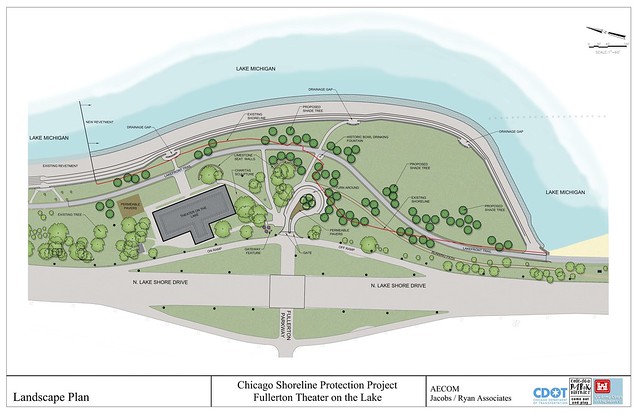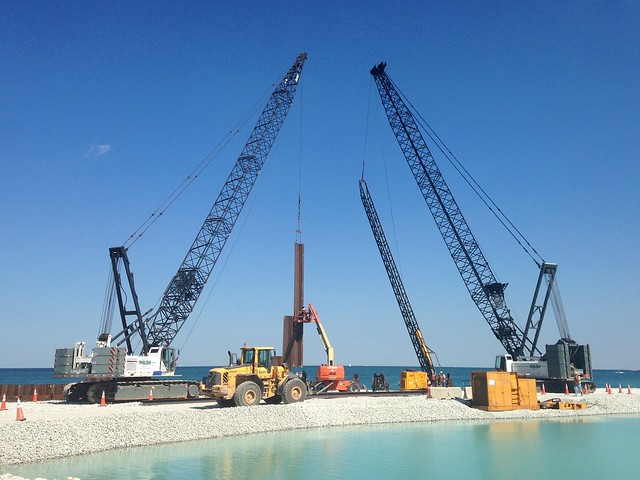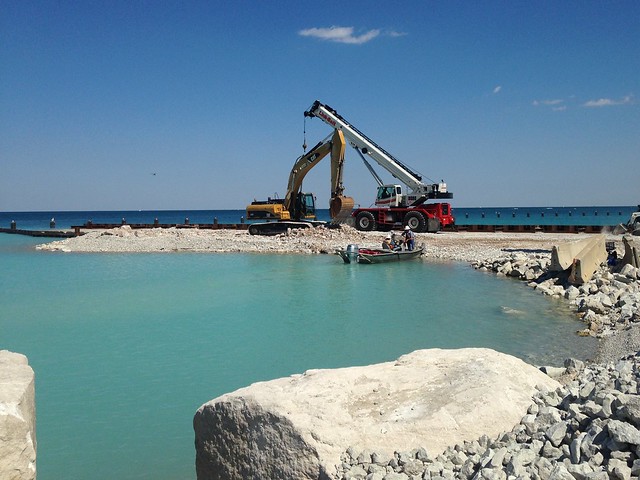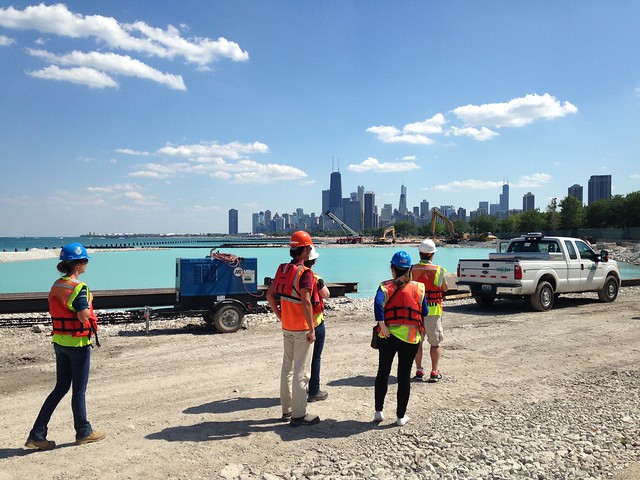
Last October, a study was released as part of the North Lake Shore Drive redesign process that found Chicagoans ranked the creation of separate paths for walking and biking on the Lakefront Trail as their top priority for improving the shoreline. That same month, the Chicago Department of Transportation and the Chicago Park District kicked off the Fullerton Revetment project, a step in the right direction towards that goal.
The initiative is building 5.8 acres of new parkland along the lake, which will allow for the partial separation of pedestrian and bike routes at a spot that’s currently a bottleneck. The main goal of the $31.5 million endeavor, funded by the U.S. Army Corps of Engineers, the city, and the park district, is to replace the crumbling seawall as part of the larger Chicago Shoreline Protection Project, which launched in 2000. Since then, 19 of the 23 segments of that 9.5-mile, $500 million project have been completed, according to city officials.
The Fullerton initiative includes widening the strip of parkland along the Lakefront Trail by as much as several hundred feet via infill, creating a brand-new hump of land that’s sure to be a hit with sunbathers. The work will also pave the way for the renovation of the Theater on the Lake, a former tuberculosis sanatorium that Mayor Rahm Emanuel has promised to turn into a year-round destination for arts and culture.
Infill and revetment construction is slated for completion by November 30, and landscaping should be done by summer of 2016. Yesterday, CDOT engineer Carlene Walsh, the Fullerton project manager, and Steven Miskowicz from the R.M. Chin and Associates, which is overseeing construction, led a tour of the worksite. The general contractor is Walsh Construction – no relation to Ms. Walsh.
Right now, the area that will be the new land resembles a tropical lagoon. Workers are driving corrugated steel pilings as much as 45 feet into the lakebed to create a wavy wall of metal that will hold the infill in place, similar to what was recently done to create new land for the Chicago Riverwalk extension. A causeway of rock and gravel has been built to provide access for the heavy equipment used to install the metal enclosure.
The resulting “bayou,” currently occupied by water that’s a milky turquoise due to sediment, will be filled in with 80,000 cubic yards of rocks and sand. The rocks include special “armor stone” that will be shipped in from Wisconsin, but the sand will be dredged from the lake floor southeast of North Avenue Beach’s hook-shaped pier, starting in about a month.
The Lakefront Trail south of Fullerton has been buffeted by waves in the past, and its asphalt usually needs to be replaced in the spring after rough winter conditions. The revetment project includes various strategies to deflect the waves and manage stormwater, so the path won’t be swamped in the future. The new concrete, stairstep-shaped seawall, which will run for about 1,700 feet will include a lower promenade six feet above the standard lake level, with the top of the revetment rising to 14 feet above the standard level.
From there, the land beyond the seawall will slope to a 16-foot ridge, which means that waves and rain on the lake side of the ridge will wash back into the lake. Water that lands on the other side of the ridge will be diverted to a drainage system that will lead back into the lake, so it won’t wind up in the city’s already-overtaxed stormwater system.
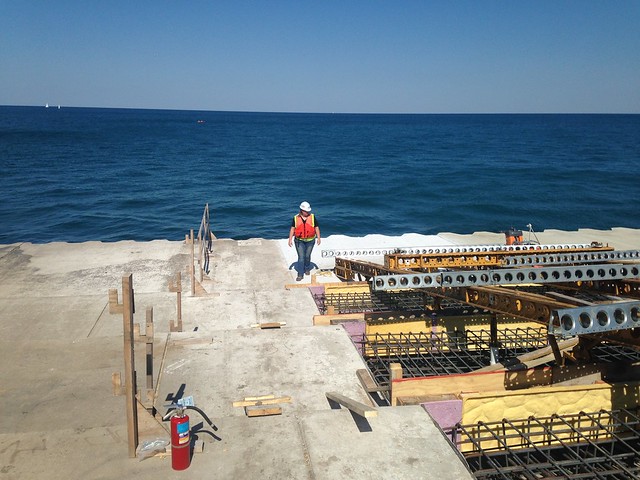
Since an old segment of the Lakefront Trail south of Fullerton lies within the construction zone, a temporary detour path was built last year on higher ground immediately next to Lake Shore Drive. After construction, the new bike trail routing will take cyclists further east, and farther away from the intersection of Fullerton Avenue and off- and on-ramps for the highway, which currently creates a chaotic “mixing bowl” situation. However, there will be access paths from Fullerton to the main trail.
In keeping with current park district standards, the new paved trail will have three-foot soft-surface running paths on either side, so pedestrians won't be discouraged from using it. However, to give walkers and joggers the option of avoiding two-wheeled traffic, there will be an unpaved path to west of the bike trail, south of Fullerton. This soft path will run for about 600 feet, only about half the length of the project, before ending at a turnaround at Fullerton.
“We only have a certain footprint to work with, and the pedestrian path would have to terminate into an existing path at some point anyway,” said Walsh. “We’ve done what we could for this project, but we’ll keep [the separation goal] in mind in the future.”
However, a glance at the plans for the project suggests that it wouldn’t have been difficult to find room to extend the soft path further north. This seems like a missed opportunity to provide more separation between pedestrians and cyclists. It's a fairly minor quibble with a project that promises to be a fine addition to our beautiful lakefront.
